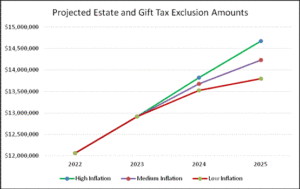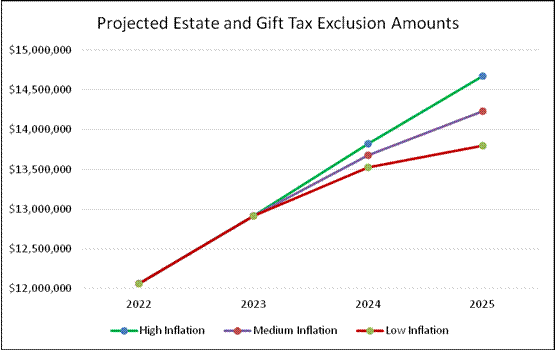Most of our content is original, but every now and then I come across an article I believe is so important I want to be sure clients, colleagues and friends have an opportunity to read it. Thanks to Steve Leimberg and Peter Tucci, as per the citation at the end of the article.
The following is well worth your time.
“Many estate planners are underestimating the magnitude of the anticipated 2023 and 2024 inflation adjustments to the estate and gift tax exclusion amounts. The 2023 inflation adjustment will be about $860,000, and the inflation adjustments in the following years should push the exclusion amount to roughly $14,000,000 by 2025 – perhaps even higher, depending on the course of inflation over the next two years. From a tax-planning perspective, this is welcome news for high-net-worth individuals, particularly those who have already made significant gifts and will now have an opportunity to make significant additional gifts without incurring gift tax.”
Peter Tucci, an associate with Proskauer’s Private Client Services Department, provides members with timely commentary that discusses the mechanics of the Internal Revenue Code’s inflation adjustment provision, the size of the coming inflation adjustments, and the impact those inflation adjustments will have on high-net-worth individuals’ estate plans.
Here is his commentary:
FACTS:
On January 1 of each year, the estate and gift tax “basic exclusion amount,” currently $12,060,000 per person, is adjusted for inflation. But, even after more than a year of high inflation, few estate planners have internalized the scale of the coming inflation adjustments.
Those inflation adjustments will dwarf this year’s $360,000 inflation adjustment – the largest on record. The 2023 inflation adjustment will be approximately $860,000. Indeed, the 2024 and 2025 inflation adjustments could easily result in mid-to-high-six-figure increases and, by January 1, 2025, the exclusion amount should be in the neighborhood of $14,000,000 per person!
These looming, massive inflation adjustments have major implications for estate planners and their clients.
COMMENT:
Estate planners can be forgiven for not giving much thought to Section 1(f)(3) of the Internal Revenue Code, which contains the formula that the Internal Revenue Service uses to determine annual inflation adjustments. Though Section 1(f)(3) has existed in some form for decades, until recently, the combination of muted inflation and a smaller basic exclusion amount meant that inflation adjustments were not particularly significant in the estate and gift tax context.
For example, the 2016 inflation adjustment boosted the estate and gift tax exclusion amount by just $20,000 (from $5,043,000 to $5,045,000). The current environment of high inflation, coupled with a large basic exclusion amount, makes understanding Section 1(f)(3) more important than ever.
Here is the basic idea of Section 1(f)(3) as applied to the estate and gift tax exclusion amount: the IRS calculates the average price level (using “C-CPI-U,” which is the Chained Consumer Price Index for Urban Consumers) between September 1 of the year two years before the inflation adjustment takes effect and August 31 of the year before the inflation adjustment takes effect.
Let’s call this 12-month period the “Measuring Period.” Technically, this average is compared to the average price level from September 1, 2009 through August 31, 2010, but because that time period is used as the benchmark every year, in effect, what Section 1(f)(3) measures is the change in the average price level between the previous Measuring Period and the current Measuring Period.
In other words, the three-percent inflation adjustment for 2022 reflects the three-percent rise in average prices between the September 1, 2019 – August 31, 2020 Measuring Period and the September 1, 2020 – August 31, 2021 Measuring Period, not the 6.7-percent rise in C-CPI-U between December 2020 and December 2021. The calendar year 2021 inflation that was not captured in the 2022 inflation adjustment will show up in the 2023 inflation adjustment, while the elevated inflation so far this year will be reflected partly in the 2024 inflation adjustment.
Stated a bit more succinctly, Section 1(f)(3) has a built-in time lag. As a result, it takes a while for real-world inflation to translate into a significantly higher exclusion amount. But, eventually, it does.
Below is a chart showing the projected increase in the exclusion amount under three different sets of assumptions. The first scenario, represented by the green line, assumes six percent inflation through at least August 2024. The second scenario, represented by the purple line, assumes four percent inflation through August 2024. In the third scenario, represented by the red line, inflation drops to two percent.

In each scenario, the exclusion amount jumps by $860,000 in 2023. In the high-inflation scenario, the exclusion amount increases by $900,000 in 2024 and $860,000 in 2025. In the medium-inflation scenario, the exclusion amount increases by $850,000 in 2024 and $560,000 in 2025. In the low-inflation scenario, the exclusion amount increases by $610,000 in 2024 and $270,000 in 2025.
Note that even in the low-inflation scenario, the 2024 inflation adjustment is enormous. That is because the 2024 inflation adjustment will account for a portion of the high inflation during the first half of 2022. At this point, large inflation adjustments for both 2023 and 2024 are baked in.
High-net-worth individuals stand to benefit from these inflation adjustments. Those who have used up all or a substantial portion of their current gift tax exclusion amounts will be able to move additional assets out of their estates ahead of the scheduled reduction in the exclusion amount on January 1, 2026.
Individuals with a large amount of unused exclusion soon will have even more. For individuals with estates that are close to, or just above, the current exclusion level, these inflation adjustments may mean the difference between a significant estate tax liability and none at all.
We should also not forget about portability for clients who die during a year with a significant amount of unused exclusion. Whether or not the exclusion is eventually reduced, the ported amount is based on the exclusion in the year of death, not the year it is eventually used by the surviving spouse.
Estate planners should urge their clients to begin thinking about possible gifting opportunities now, rather than waiting until 2025, both to get ahead of the late-2025 rush and to give clients time to implement multi-year planning strategies. In some cases, knowing that more exclusion will be available in the near future may change the planning calculus.
For example, imagine that Z has used up $11,700,000 of gift tax exclusion by making a large gift in 2021. Z would like to take advantage of depressed stock market valuations by transferring stock to her children now, before the market fully recovers. Under normal circumstances, a GRAT would be an attractive option for someone like Z. But, given the coming inflation adjustments, Z might consider simply loaning $2,000,000 of stock to an intentionally defective grantor trust for her children’s benefit, knowing that she will likely have sufficient exclusion to forgive the loan in the not-too-distant future.
For estate planning attorneys, the coming inflation adjustments mean that 2024 and 2025 may be busier than anticipated, as even clients who made large gifts in recent years will have significant unused gift tax exclusion available to them by the middle of the decade.
Conclusion:
The 2023 inflation adjustment to the estate and gift tax exclusion amount will be by far the largest in history, and the 2024 inflation adjustment will be large as well. These inflation adjustments will have a profound impact on the estate planning landscape for high-net-worth individuals. Estate planning professionals and their clients should be making planning decisions against that backdrop.
Reference:
LISI Estate Planning Newsletter #2980 (September 14, 2022) at http://www.leimbergservices.com.
Copyright 2022 Leimberg Information Services, Inc.











